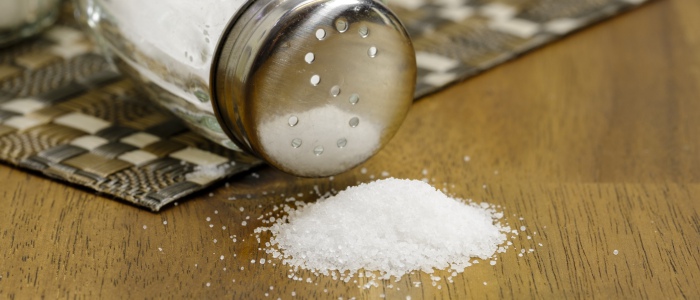
While most food items don’t exceed the daily limit of 5g of salt
per day, it is the combined amount of salt from all the foods we
eat in a day that often amounts to eight times the recommended
daily allowance, putting South Africans in the red zone for heart disease.
To test SA’s salt-smarts, a prevention-minded pharma company conducted an online poll among men and women across the country in the weeks leading up to World Salt Awareness Week (4 – 10 March).
Here are some of the findings.
A quarter of South Africans conceded to being salt addicts, with 31% adding salt to their food ‘all the time’ and 37% ‘some of the time’. Most also still don’t have a handle on how much salt is used in popular foods such as cereal, yoghurt and chips.
Nicole Jennings, spokesperson for Pharma Dynamics – SA’s leading provider of cardiovascular medication – says hypertension rates in SA are alarmingly high and continue to climb.
“A leading cause of the condition is too much salt consumption, which heightens the risk of heart disease and stroke. There are various ways in which excessive salt consumption can impact our blood pressure and put great strain on our hearts, arteries and kidneys.
“We live in a fast-paced society, where take-outs and ready-made meals reign supreme, but these are often laden with salt.
“Our survey, which polled 245 men and women across the country, found that while more than 90% understood the link between hypertension and excessive salt consumption, very few actually knew just how much salt is contained in food that is consumed on an almost daily basis,” she remarks.
More than 64% of respondents didn’t know that there is about 1.5g of salt in a slice of pizza; 45% were off the mark with how much salt was in a small tub of plain yoghurt; 60% was clueless about the amount of salt in an average take-away beef hamburger, which is in the region of 3.5g; 60% guessed wrong about the quantity of salt in a bowl of cornflakes with milk and 68% didn’t know how much salt was in a handful of peanuts.
While efforts have been made since 2016 by government to reduce salt levels in food, with a second set of even lower levels of salt being introduced this year, the public should be made more aware of foods that are high in salt as many don’t pay attention to food labels,” says Jennings.
In an effort to make the public more salt savvy, Pharma Dynamics has compiled a list of food that are typically high in salt:
Very high in salt |
Moderately high in salt |
Surprisingly contain salt |
|
- Cheese, flavoured cream cheese and cottage cheese - Tinned foods, especially those preserved in brine - Stock powders or cubes - Soup powders or tinned soups - Marinades or marinade powders - Olives and pickles - Any processed meat: polony, ham, salami, turkey, sausages, Viennas etc - Any takeaway fast foods, like burgers, fish and chips, crumbed chicken, pizzas and Chinese takeaway - Seasoning salts, like barbeque or chicken spice - Salty spreads, including margarine, butter, cheese spreads and meat spreads - Cured meat and fish: bokkoms, bacon, biltong, anchovies, corned beef - Instant noodles with flavouring - Worcestershire sauce and soy sauce - Crisps, salted biscuits and crackers and ready-made popcorn |
- Pre-prepared meals or convenience foods - Shop-bought biscuits, cakes and treats - Salad dressings and mayonnaise - Salted nuts
|
- Ready-made desserts - Some yoghurts - Bread - Breakfast cereals
|
According to the Heart and Stroke Foundation, South Africa has the highest incidence of high blood pressure among people aged 50+ compared to any other country in the world, with almost eight in ten people in this age group being diagnosed with high blood pressure. However, younger people are also at risk with an estimated one in three South Africans older than 15 having high blood pressure.
Jennings believe that the country’s high hypertension rates should be tackled early in childhood already.
“In many cases, adult hypertension has its roots in childhood, yet worryingly very little is being done to make children aware that salt can lead to heart disease. If healthy habits, which includes a reduction in salt intake, can be formed in early years, it could significantly decrease the burden of heart disease in our country.”
Based on recent research published in the SA Medical Journal (September 2018), one in five children at the age of five is hypertensive and 60% of children with elevated blood pressure maintain that status into adulthood.
By decreasing salt consumption by even just 0.85g per day, deaths related to heart disease could be decreased by 7 400 and would result in 4 300 fewer non-fatal strokes per year.
“It’s essential that South Africans take steps to make sure they know how much salt is in all the food they eat and try to cut back as much as they can. When checking food labels, look out for other terms often used to describe salt, such as monosodium glutamate, nitrates and nitrites so you’re aware of how much salt you’re putting into your body. Also try to avoid salting food that has already been salted,” encourages Jennings.
For nutritional advice and recipes that are low in salt, visit www.cookingfromtheheart.co.za
For further information, contact Brigitte Taim from Meropa on 021 683 6464, 082 410 8960 or brigittet@meropa.co.za.



